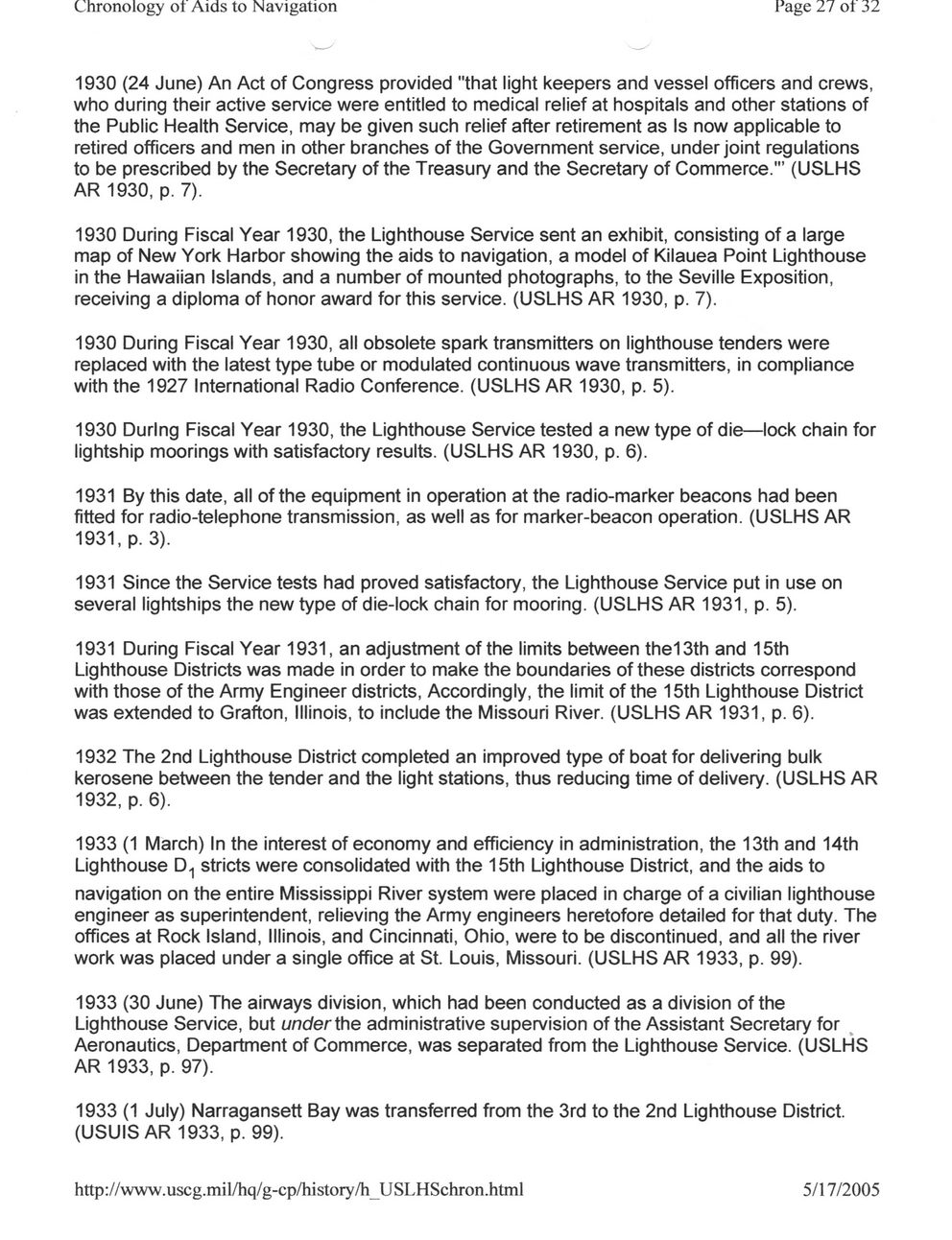This text was obtained via automated optical character recognition.
It has not been edited and may therefore contain several errors.
Chronology ot Aids to Navigation Page 27 or 32 1930 (24 June) An Act of Congress provided "that light keepers and vessel officers and crews, who during their active service were entitled to medical relief at hospitals and other stations of the Public Health Service, may be given such relief after retirement as Is now applicable to retired officers and men in other branches of the Government service, under joint regulations to be prescribed by the Secretary of the Treasury and the Secretary of Commerce."’ (USLHS AR 1930, p. 7). 1930 During Fiscal Year 1930, the Lighthouse Service sent an exhibit, consisting of a large map of New York Harbor showing the aids to navigation, a model of Kilauea Point Lighthouse in the Hawaiian Islands, and a number of mounted photographs, to the Seville Exposition, receiving a diploma of honor award for this service. (USLHS AR 1930, p. 7). 1930 During Fiscal Year 1930, all obsolete spark transmitters on lighthouse tenders were replaced with the latest type tube or modulated continuous wave transmitters, in compliance with the 1927 International Radio Conference. (USLHS AR 1930, p. 5). 1930 During Fiscal Year 1930, the Lighthouse Service tested a new type of die—lock chain for lightship moorings with satisfactory results. (USLHS AR 1930, p. 6). 1931 By this date, all of the equipment in operation at the radio-marker beacons had been fitted for radio-telephone transmission, as well as for marker-beacon operation. (USLHS AR 1931, p. 3). 1931 Since the Service tests had proved satisfactory, the Lighthouse Service put in use on several lightships the new type of die-lock chain for mooring. (USLHS AR 1931, p. 5). 1931 During Fiscal Year 1931, an adjustment of the limits between the13th and 15th Lighthouse Districts was made in order to make the boundaries of these districts correspond with those of the Army Engineer districts, Accordingly, the limit of the 15th Lighthouse District was extended to Grafton, Illinois, to include the Missouri River. (USLHS AR 1931, p. 6). 1932 The 2nd Lighthouse District completed an improved type of boat for delivering bulk kerosene between the tender and the light stations, thus reducing time of delivery. (USLHS AR 1932, p. 6). 1933 (1 March) In the interest of economy and efficiency in administration, the 13th and 14th Lighthouse D1 stricts were consolidated with the 15th Lighthouse District, and the aids to navigation on the entire Mississippi River system were placed in charge of a civilian lighthouse engineer as superintendent, relieving the Army engineers heretofore detailed for that duty. The offices at Rock Island, Illinois, and Cincinnati, Ohio, were to be discontinued, and all the river work was placed under a single office at St. Louis, Missouri. (USLHS AR 1933, p. 99). 1933 (30 June) The airways division, which had been conducted as a division of the Lighthouse Service, but under the administrative supervision of the Assistant Secretary for Aeronautics, Department of Commerce, was separated from the Lighthouse Service. (USLHS AR 1933, p. 97). 1933 (1 July) Narragansett Bay was transferred from the 3rd to the 2nd Lighthouse District. (USUIS AR 1933, p. 99). http://www.uscg.mil/hq/g-cp/history/h_USLHSchron.html 5/17/2005

Lighthouses Chronology-of-Aids-to-Navigation-(27)